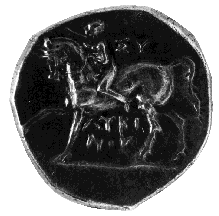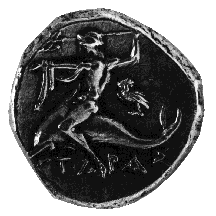



(2) Taras, Calabria (Italy) - AR stater, 272-235 B.C.,
6.29 g. (inv. 91.004).
Obverse: Boy-rider crowning horse l.; above and beneath
horse, : Sylykinos.
Reverse: Taras or Phalanthos riding dolphin l. and wielding
trident in r.; owl in r. field;
![]() : Taras.
: Taras.
Provenance: Edward Gans, 1959.
Bibliography: A.J. Evans, "The 'horsemen' of Tarentum,"
Numismatic Chronicle 1881, 1 ff.;
G.C. Brauer, Jr., Taras: its History and Coinage (New Rochelle, NY
1986).
According to tradition, Taras was founded in 706 B.C. by colonists from
Sparta. The story of its foundation is reflected in its most familiar coin
type, a figure riding on a dolphin. Some identify the figure as Phalanthos,
the leader of the Spartan colonists who was shipwrecked before he reached
Taras but saved by a dolphin that carried him ashore (Pausanias, Description
of Greece, 10.13.10). Whether Phalanthos was an historical figure is
not known; he was worshipped as a hero in Taras. Others identify the figure
as Taras, the local hero for whom the city was named, particularly since
the figure is usually accompanied by the name Taras. A son of the sea god
Poseidon, he too was saved from a shipwreck by a dolphin sent by his father.
According to the account of Pausanias, both Phalanthos and Taras, as well
as the helpful dolphin, were featured in a fifth-century statuary group
set up by the Tarantines in the sanctuary of Apollo at Delphi to commemorate
a victory over barbarians from the north.
When the dolphin rider was moved to the reverse of the coins in the late
fifth century, he was replaced on the obverse by the famous Tarantine horsemen,
who were depicted on the coins for another two hundred years with considerable
diversity and inventiveness. The horsemen cannot be specifically identified;
they range from boys to youths, from nude to armed, and engage in a wide
variety of equestrian activities, perhaps alluding to athletic games held
at Taras. The nude rider on this coin crowns his horse, probably in celebration
of victory in a contest.
C.L.L.



All contents copyright (c) 1996.
Lawrence University
All rights reserved.